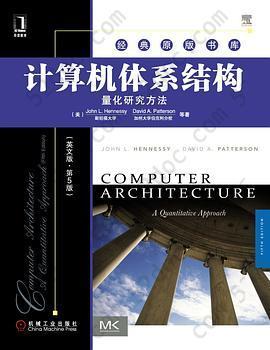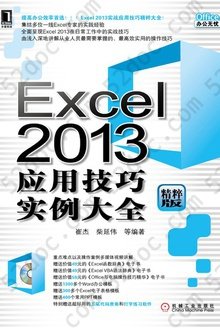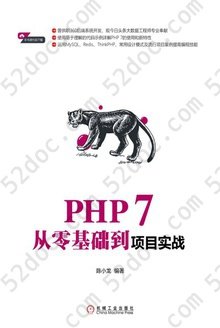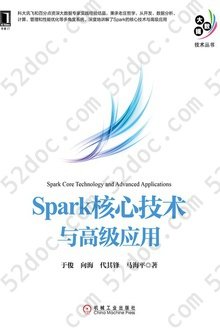注重体验与质量的电子书资源下载网站
分类于: 互联网 人工智能
简介

计算机体系结构: 量化研究方法(英文版·第5版) 豆 9.5分
资源最后更新于 2020-08-23 08:20:49
作者:John L. Hennessy
出版社:机械工业出版社
出版日期:2012-01
ISBN:9787111364580
文件格式: pdf
标签: 计算机体系结构 计算机 计算机科学 体系结构 经典 经典著作 CS 计算机系统
简介· · · · · ·
编辑推荐
“本书之所以成为永恒的经典,是因为它的每一次再版都不仅仅是更新补充,而是一次全面的修订,对这个激动人心且快速变化领域给出了最及时的信息和最独到的解读。对于我来说,即使已有二十多年的从业经历,再次阅读本书仍自觉学无止境,感佩于两位卓越大师的渊博学识和深厚功底。”
——Luiz André Barroso,Google公司
内容简介
本书堪称计算机系统结构学科的“圣经”,是计算机设计领域学生和实践者的必读经典。本书系统地介绍了计算机系统的设计基础、存储器层次结构设计、指令级并行及其开发、数据级并行、GPU体系结构、线程级并行和仓库级计算机等。
现今计算机界处于变革之中:移动客户端和云计算正在成为驱动程序设计和硬件创新的主流范型。因此在这个最新版中,作者考虑到这个巨大的变化,重点关注了新的平台(个人移动设备和仓库级计算机)和新的体系结构(多核和G...
目录
Foreword
Preface
Acknowledgments
Chapter 1 Fundamentals of Quantitative Design and Analysis
1.1 Introduction
1.2 Classes of Computers
1.3 Defining Computer Architecture
1.4 Trends in Technology
1.5 Trends in Power and Energy in Integrated Circuits
1.6 Trends in Cost
1.7 Dependability
1.8 Measuring, Reporting, and Summarizing Performance
1.9 Quantitative Principles of Computer Design
1.10 Putting It All Together: Performance, Price, and Power
1.11 Fallacies and Pitfalls
1.12 Concluding Remarks
1.13 Historical Perspectives and References Case Studies and Exercises by Diana Franklin
Chapter 2 Memory Hierarchy Design
2.1 Introduction
2.2 Ten Advanced Optimizations of Cache Performance
2.3 Memory Technology and Optimizations
2.4 Protection: Virtual Memory and Virtual Machines
2.5 Crosscutting Issues: The Design of Memory Hierarchies
2.6 Putting It All Together: Memory Hierachies in the ARM Cortex-AS and Intel Core i7
2.7 Fallacies and Pitfalls
2.8 Concluding Remarks: Looking Ahead
2.9 Historical Perspective and References Case Studies and Exercises by Norman P. Jouppi, Naveen Muralimanohar, and Sheng Li
Chapter 3 nstruction-Level Parallelism and Its Exploitation
3.1 Instruction-Level Parallelism: Concepts and Challenges
3.2 Basic Compiler Techniques for Exposing ILP
3.3 Reducing Branch Costs with Advanced Branch Prediction
3.4 Overcoming Data Hazards with Dynamic Scheduling
3.5 Dynamic Scheduling: Examples and the Algorithm
3.6 Hardware-Based Speculation
3.7 Exploiting ILP Using Multiple Issue and Static Scheduling
3.8 Exploiting ILP Using Dynamic Scheduling, Multiple Issue, and Speculation
3.9 Advanced Techniques for Instruction Delivery and Speculation
3.10 Studies of the Limitations oflLP
3.11 Cross-Cutting Issues: ILP Approaches and the Memory System
3.12 Multithreading: Exploiting Thread-Level Parallelism to Improve Uniprocessor Throughput
3.13 Putting It All Together: The Intel Core i7 and ARM Cortex-AS
3.14 Fallacies and Pitfalls
3.15 Concluding Remarks: What's Ahead?
3.16 Historical Perspective and References Case Studies and Exercises by Jason D. Bakos and Robert R Colwell
Chapter4 Data-Level Parallelism in Vector, SIMD, and GPU Architectures
4.1 Introduction
4.2 Vector Architecture
4.3 SIMD Instruction Set Extensions for Multimedia
4.4 Graphics Processing Units
4.5 Detecting and Enhancing Loop-Level Parallelism
4.6 Crosscutting Issues
4.7 Putting It All Together: Mobile versus Server GPUS and Tesla versus Core i7
4.8 Fallacies and Pitfalls
4.9 Concluding Remarks
4.10 Historical Perspective and References Case Study and Exercises by Jason D. Bakos
Chapter 5 Thread-Level Parallelism
5.1 Introduction
5.2 Centralized Shared-Memory Architectures
5.3 Performance of Symmetric Shared-Memory Multiprocessors
5.4 Distributed Shared-Memory and Directory-Based Coherence
5.5 Synchronization: The Basics
5.6 Models of Memory Consistency: An Introduction
5.7 Crosscutting Issues
5.8 Putting It All Together: Multicore Processors and Their Performance
5.9 Fallacies and Pitfalls
5.10 Concluding Remarks
5.11 Historical Perspectives and References
Case Studies and Exercises by Amr Zaky and David A. Wood
Chapter 6 Warehouse-Scale Computers to Exploit Request-Level and
Data-Level Parallelism
6.1 Introduction
6.2 Programming Models and'Workloads for Warehouse-Scale Computers
6.3 Computer Architecture of Warehouse-Scale Computers
6.4 Physical Infrastructure and Costs of Warehouse-Scale Computers
6.5 Cloud Computing: The Return of Utility Computing
6.6 Crosscutting Issues
6.7 Putting It All Together: A Google Warehouse-Scale Computer
6.8 Fallacies and Pitfalls
6.9 Concluding Remarks
6.10 Historical Perspectives and References
Case Studies and Exercises by Parthasarathy Ranganathan
Appendix A Instruction Set Principles
A.1 Introduction
A.2 Classifying Instruction Set Architectures
A.3 Memory Addressing
A.4 Type and Size of Operands
A.S Operations in the Instruction Set
A.6 Instructions for Control Flow
A.7 Encoding an Instruction Set
A.8 Crosscutting Issues: The Role of Compilers
A.9 Putting It All Together: The MIPS Architecture
A.10 Fallacies and Pitfalls
A.11 Concluding Remarks
A.12 Historical Perspective and References
Exercises by Gregory D. Peterson
Appendix B Review of Memory Hierarchy
B.1 Introduction
B.2 Cache Performance
B.3 Six Basic Cache Optimizations
B.4 Virtual Memory
B.5 Protection and Examples of Virtual Memory
B.6 Fallacies and Pitfalls
B.7 Concluding Remarks
B.8 Historical Perspective and References
Exercises by Amr Zaky
Appendix C Pipelining: Basic and Intermediate Concepts
C.1 Introduction
C.2 The Major Hurdle of Pipelining--Pipeline Hazards
C.3 How Is Pipelining Implemented?
C,4 What Makes Pipelining Hard to Implement?
C.5 Extending the MIPS Pipeline to Handle Multicycle Operations
C.6 Putting It All Together: The MIPS R4000 Pipeline
C.7 Crosscutting Issues
C.8 Fallacies and Pitfalls
C.9 Concluding Remarks
C.10 Historical Perspective and References
Updated Exercises by Diana Franklin
Online Appendices
Appendix D Storage Systems
Appendix E Embedded Systems
By ThomasM Conte
Appendix F Interconnection Networks
Revised by Timothy M. Pinkston ond Jose Duoto
Appendix G Vector Processors in More Depth
Revised by Krste Asonovic
Appendix H Hardware and Software for VLIW and EPIC
Appendix I Large-Scale Multiprocessors and Scientific Applications
Appendix J Computer Arithmetic
by David Goldberg
Appendix K Survey of Instruction Set Architectures
Appendix L Historical Perspectives and References
References
Index
1.1 Introduction
1.2 Classes of Computers
1.3 Defining Computer Architecture
1.4 Trends in Technology
1.5 Trends in Power and Energy in Integrated Circuits
1.6 Trends in Cost
1.7 Dependability
1.8 Measuring Reporting, and Summarizing Performance
1.9 Quantitative Principles of Computer Design
1.10 Putting It All Together: Performance, Price, and Power
1.11 Fallacies and Pitfalls
1.12 Concluding Remarks
1.13 Historical Perspectives and References
1.14 Case Studies and Exercises by Diana Franklin
Preface
Acknowledgments
Chapter 1 Fundamentals of Quantitative Design and Analysis
1.1 Introduction
1.2 Classes of Computers
1.3 Defining Computer Architecture
1.4 Trends in Technology
1.5 Trends in Power and Energy in Integrated Circuits
1.6 Trends in Cost
1.7 Dependability
1.8 Measuring, Reporting, and Summarizing Performance
1.9 Quantitative Principles of Computer Design
1.10 Putting It All Together: Performance, Price, and Power
1.11 Fallacies and Pitfalls
1.12 Concluding Remarks
1.13 Historical Perspectives and References Case Studies and Exercises by Diana Franklin
Chapter 2 Memory Hierarchy Design
2.1 Introduction
2.2 Ten Advanced Optimizations of Cache Performance
2.3 Memory Technology and Optimizations
2.4 Protection: Virtual Memory and Virtual Machines
2.5 Crosscutting Issues: The Design of Memory Hierarchies
2.6 Putting It All Together: Memory Hierachies in the ARM Cortex-AS and Intel Core i7
2.7 Fallacies and Pitfalls
2.8 Concluding Remarks: Looking Ahead
2.9 Historical Perspective and References Case Studies and Exercises by Norman P. Jouppi, Naveen Muralimanohar, and Sheng Li
Chapter 3 nstruction-Level Parallelism and Its Exploitation
3.1 Instruction-Level Parallelism: Concepts and Challenges
3.2 Basic Compiler Techniques for Exposing ILP
3.3 Reducing Branch Costs with Advanced Branch Prediction
3.4 Overcoming Data Hazards with Dynamic Scheduling
3.5 Dynamic Scheduling: Examples and the Algorithm
3.6 Hardware-Based Speculation
3.7 Exploiting ILP Using Multiple Issue and Static Scheduling
3.8 Exploiting ILP Using Dynamic Scheduling, Multiple Issue, and Speculation
3.9 Advanced Techniques for Instruction Delivery and Speculation
3.10 Studies of the Limitations oflLP
3.11 Cross-Cutting Issues: ILP Approaches and the Memory System
3.12 Multithreading: Exploiting Thread-Level Parallelism to Improve Uniprocessor Throughput
3.13 Putting It All Together: The Intel Core i7 and ARM Cortex-AS
3.14 Fallacies and Pitfalls
3.15 Concluding Remarks: What's Ahead?
3.16 Historical Perspective and References Case Studies and Exercises by Jason D. Bakos and Robert R Colwell
Chapter4 Data-Level Parallelism in Vector, SIMD, and GPU Architectures
4.1 Introduction
4.2 Vector Architecture
4.3 SIMD Instruction Set Extensions for Multimedia
4.4 Graphics Processing Units
4.5 Detecting and Enhancing Loop-Level Parallelism
4.6 Crosscutting Issues
4.7 Putting It All Together: Mobile versus Server GPUS and Tesla versus Core i7
4.8 Fallacies and Pitfalls
4.9 Concluding Remarks
4.10 Historical Perspective and References Case Study and Exercises by Jason D. Bakos
Chapter 5 Thread-Level Parallelism
5.1 Introduction
5.2 Centralized Shared-Memory Architectures
5.3 Performance of Symmetric Shared-Memory Multiprocessors
5.4 Distributed Shared-Memory and Directory-Based Coherence
5.5 Synchronization: The Basics
5.6 Models of Memory Consistency: An Introduction
5.7 Crosscutting Issues
5.8 Putting It All Together: Multicore Processors and Their Performance
5.9 Fallacies and Pitfalls
5.10 Concluding Remarks
5.11 Historical Perspectives and References
Case Studies and Exercises by Amr Zaky and David A. Wood
Chapter 6 Warehouse-Scale Computers to Exploit Request-Level and
Data-Level Parallelism
6.1 Introduction
6.2 Programming Models and'Workloads for Warehouse-Scale Computers
6.3 Computer Architecture of Warehouse-Scale Computers
6.4 Physical Infrastructure and Costs of Warehouse-Scale Computers
6.5 Cloud Computing: The Return of Utility Computing
6.6 Crosscutting Issues
6.7 Putting It All Together: A Google Warehouse-Scale Computer
6.8 Fallacies and Pitfalls
6.9 Concluding Remarks
6.10 Historical Perspectives and References
Case Studies and Exercises by Parthasarathy Ranganathan
Appendix A Instruction Set Principles
A.1 Introduction
A.2 Classifying Instruction Set Architectures
A.3 Memory Addressing
A.4 Type and Size of Operands
A.S Operations in the Instruction Set
A.6 Instructions for Control Flow
A.7 Encoding an Instruction Set
A.8 Crosscutting Issues: The Role of Compilers
A.9 Putting It All Together: The MIPS Architecture
A.10 Fallacies and Pitfalls
A.11 Concluding Remarks
A.12 Historical Perspective and References
Exercises by Gregory D. Peterson
Appendix B Review of Memory Hierarchy
B.1 Introduction
B.2 Cache Performance
B.3 Six Basic Cache Optimizations
B.4 Virtual Memory
B.5 Protection and Examples of Virtual Memory
B.6 Fallacies and Pitfalls
B.7 Concluding Remarks
B.8 Historical Perspective and References
Exercises by Amr Zaky
Appendix C Pipelining: Basic and Intermediate Concepts
C.1 Introduction
C.2 The Major Hurdle of Pipelining--Pipeline Hazards
C.3 How Is Pipelining Implemented?
C,4 What Makes Pipelining Hard to Implement?
C.5 Extending the MIPS Pipeline to Handle Multicycle Operations
C.6 Putting It All Together: The MIPS R4000 Pipeline
C.7 Crosscutting Issues
C.8 Fallacies and Pitfalls
C.9 Concluding Remarks
C.10 Historical Perspective and References
Updated Exercises by Diana Franklin
Online Appendices
Appendix D Storage Systems
Appendix E Embedded Systems
By ThomasM Conte
Appendix F Interconnection Networks
Revised by Timothy M. Pinkston ond Jose Duoto
Appendix G Vector Processors in More Depth
Revised by Krste Asonovic
Appendix H Hardware and Software for VLIW and EPIC
Appendix I Large-Scale Multiprocessors and Scientific Applications
Appendix J Computer Arithmetic
by David Goldberg
Appendix K Survey of Instruction Set Architectures
Appendix L Historical Perspectives and References
References
Index
1.1 Introduction
1.2 Classes of Computers
1.3 Defining Computer Architecture
1.4 Trends in Technology
1.5 Trends in Power and Energy in Integrated Circuits
1.6 Trends in Cost
1.7 Dependability
1.8 Measuring Reporting, and Summarizing Performance
1.9 Quantitative Principles of Computer Design
1.10 Putting It All Together: Performance, Price, and Power
1.11 Fallacies and Pitfalls
1.12 Concluding Remarks
1.13 Historical Perspectives and References
1.14 Case Studies and Exercises by Diana Franklin








